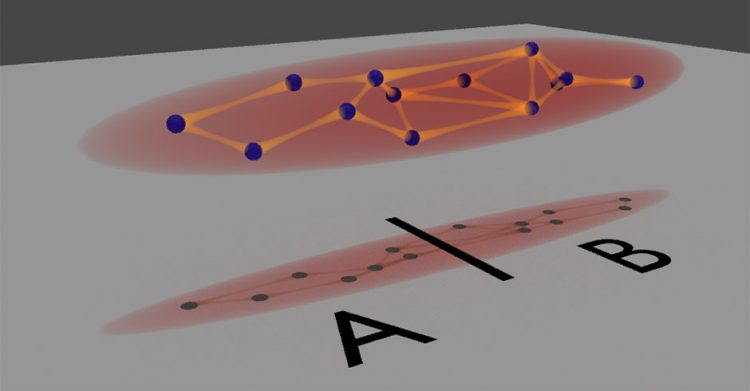Quantum Mechanics: Entanglements In Ultracold Atomic Clouds

Photo: Philipp Kunkel, SynQS Schematic representation of the experimental implementation: A cigar-shaped cloud of rubidium atoms (blue dots) is cooled to ultra-cold temperatures. Due to collisions between atoms, quantum correlations, also called entanglement, build up (yellow compounds). The atomic cloud is finally imaged onto a camera with the aid of laser light. Due to the high spatial resolution of the camera, correlations between different parts (A and B) of the condensate, and in particular their quantum mechanical character, can be detected.
A system's state is characterised as entangled or quantum correlated if two or more particles cannot be described as a combination of separate, independent states but only as a whole. Researchers at the Kirchhoff Institute for Physics of Heidelberg University recently succeeded in verifying so-called non-local quantum correlations between ultracold clouds of rubidium atoms. Under the direction of Prof. Dr Markus Oberthaler und Prof. Dr Thomas Gasenzer, the researchers were able to gain important new insights into the character of quantum mechanical many-body systems.
The correlations that the theory of quantum mechanics predicts are counter-intuitive. These quantum correlations seem to contradict the Heisenberg uncertainty principle, which states that two properties of an object, such as position and speed, can never be precisely determined at the same time.
In quantum mechanical systems, however, two particles can be prepared so as to accurately predict the position of particle two by localising the position of particle one. Similarly, measuring the speed of one particle allows predicting the speed of the other.
“In this case, the position and speed of particle two do need to be precisely determined prior to measurement,” explains Prof. Oberthaler. “The measurement result for particle one cannot be immediately present at particle two's position if the two are spatially separate.”
The uncertainty principle actually does not support this simultaneous determination of position and speed. But in quantum mechanics, two objects are not considered separate if they are correlated, i.e., entangled, hence resolving the apparent contradiction.
“If we can prove that measurement results of different observables in one system can actually be predicted by measuring a second, remote system, then we can use this evidence to substantiate entanglement as well – and that's exactly what we did in our experiment,” states Philipp Kunkel, the study's primary author.
In their experiment, the researchers used a cloud of approximately 11,000 rubidium atoms, which they cooled to extremely low temperatures. Using laser light, they kept the atoms suspended in a vacuum chamber, which allowed them to exclude any disturbing effects, such as collisions with air molecules.
Because quantum effects are detectable only at very low temperatures, working with ultracold atoms is required. Like when measuring position and speed, these extreme conditions allow the internal state of the particles, often called spin, to be measured as well. “By measuring the spin in one half of the cloud, we were able to predict the spin in the other more accurately than the local uncertainty principle would allow,” explains Philipp Kunkel.
The characterisation of quantum mechanical many-body systems is important for future applications such as quantum computers and quantum communication, among others. The most recent Heidelberg research results were published in “Science”.
Original publication:
P. Kunkel, M. Prüfer, H. Strobel, D. Linnemann, A. Frölian, T. Gasenzer, M. Gärttner, M.K. Oberthaler: Spatially distributed multipartite entanglement enables EPR steering of atomic clouds. Science (published online 27 April 2018), doi: 10.1126/science.aao2254
Internet information:
Contact:
Prof. Dr. Markus Oberthaler
Kirchhoff Institute for Physics
Phone +49 6221 54-5170
markus.oberthaler@kip.uni-heidelberg.de
Communications and Marketing
Press Office
Phone +49 6221 54-2311
presse@rektorat.uni-heidelberg.de
Media Contact
More Information:
http://www.uni-heidelberg.deAll latest news from the category: Physics and Astronomy
This area deals with the fundamental laws and building blocks of nature and how they interact, the properties and the behavior of matter, and research into space and time and their structures.
innovations-report provides in-depth reports and articles on subjects such as astrophysics, laser technologies, nuclear, quantum, particle and solid-state physics, nanotechnologies, planetary research and findings (Mars, Venus) and developments related to the Hubble Telescope.
Newest articles

First-of-its-kind study uses remote sensing to monitor plastic debris in rivers and lakes
Remote sensing creates a cost-effective solution to monitoring plastic pollution. A first-of-its-kind study from researchers at the University of Minnesota Twin Cities shows how remote sensing can help monitor and…

Laser-based artificial neuron mimics nerve cell functions at lightning speed
With a processing speed a billion times faster than nature, chip-based laser neuron could help advance AI tasks such as pattern recognition and sequence prediction. Researchers have developed a laser-based…

Optimising the processing of plastic waste
Just one look in the yellow bin reveals a colourful jumble of different types of plastic. However, the purer and more uniform plastic waste is, the easier it is to…


